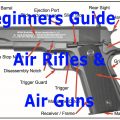Some of the links below are affiliate links, meaning, at no additional cost to you, we will earn a commission if you click through and make a purchase.
If you’re thinking of buying an air rifle, you may not know which type to buy. The type you choose will affect how easy the rifle is to shoot and maintain. There are four main types of air files, and three use some form of a compressed air tank. Let’s take a closer look at each type, so you can determine which one is the best choice for you.
Pneumatic
Pneumatic rifles are powered by compressed air, and there are a few different ways to get air compressed in the gun. There are three types of pneumatic air rifles: pump-up, single-stroke and PCP.
Pump-up, or multi-stroke, pneumatics are most common. As you may have guessed, you’ll need to pump this type of air gun. Most pump pneumatics take between two and ten strokes to get the internal pressure needed to power the pellet. These rifles are typically recoilless, compact and very lightweight. They’re in the light to medium power range.
The biggest issue with this type of pneumatic is that it requires a great deal of physical effort to get a shot off. And by the time you’re ready to take a second shot, you’re target is probably long gone.
A single-stroke pneumatic is the format used on quite a few high end competition air rifles. One single motion of the cocking lever compresses the air and powers the pellet. It’s low powered, but incredibly accurate, which is why it’s used in 10 meter competitions.
The final type of pneumatic is PCP (or Pre-Charged Pnuematic), which gives you the best of both worlds. Air is compressed in a scuba tank or a carbon fiber tank. A special hose with a pressure gauge attachments is used to connect the gun to the tank. PCPs have various configurations, and you can find both single shot and multi-shot versions of this air rifle.
Spring-Piston
Spring-piston air rifles are the type of air gun that most people are familiar with. They’re the easiest to shoot and maintain. And break-barrel rifles are what most shooters get started with. Break-barrels are common, but you’ll also find spring-piston rifles that are cocked by an underlever, side-lever or a top-lever.
Spring-piston rifles are highly durable, but the springs do wear out in time. The good news is that replacing the spring piston is relatively inexpensive.
Gas Ram
Gas ram air rifles are similar to spring-piston guns in that both types are cocked and shot the same way. But unlike a spring-piston gun, cocking a gas ram rifle compresses a piston and compressed air in a tube (similar to the pneumatic rifles mentioned earlier). The tube is filled with compressed air, but cocking the rifle compresses the air even more. When the trigger is released, the piston is pushed forward and air is forced into the compression chamber. This powers the pellet down the barrel.
The great thing about gas ram rifles is that they retain the air in the cylinder and last for years. Shots are smooth too because there’s no metal spring inside of the gun.
CO2
Just as its name implies, CO2 air rifles are powered by CO2. The one unique thing about this type of air rifle is that power and capacity are affected by temperature.
When kept at room temperature, a typical cartridge will yield 900-1000psi, which is pretty consistent. However, if the temperature rises or drops, the point of impact can change dramatically.
Temperature changes can be a problem, but professional shooters arrive hours early to allow their cartridge to adjust to the ambient temperature.



